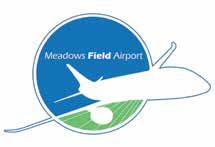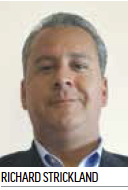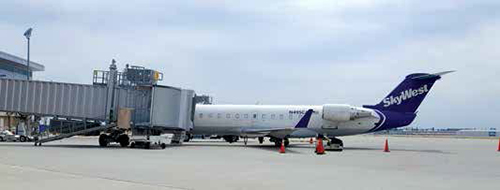Meadows Field Reduces Runway Reconstruction Cost With Quarter-Crown Design

When officials at Meadows Field Airport (BFL) in Bakersfield, CA, started planning to replace the facility's aging main runway, they expected a price tag of around $10 million. But the initial tally approached $70 million, prompting a bad case of sticker shock.
Currently, the project is expected to cost $49 million-about 30% less than the original estimate. BFL will pay $4.9 million, and the FAA is funding the balance over three years via Airport Improvement Program grants.
 FACTS&FIGURES FACTS&FIGURESProject: Reconstruction of Main Runway Location: Meadows Field Airport (Bakersfield, CA) 2015 Enplanements: 270,000 Length of Main Runway: 10,855 ft. Project Cost: $49 million Primary Components: New quarter-crown runway; removing 12 taxiways & building 5 new taxiways; edge & centerline lighting Funding: FAA grants (90%); airport funds (10%) Consultant: Mead & Hunt Phase 1 Contractor: Security Paving Co. Barricades & Lighting: United Safety Systems Noteworthy Details: Using quarter-crown design & reducing number of taxiways cut $21 million of costs; planners phased project over 3 years to help secure FAA funding Key Benefits: Enhanced safety & operational efficiency; satisfying new federal requirements |
The substantial cost difference can be summarized in three Cs: communication, cooperation and consultants.
The project officially took off after an inspection in May 2013 revealed longitudinal and horizontal cracks in the airport's 10,855-foot main runway. Richard Strickland had just become director of airports for the Kern County Department of Airports, which operates seven facilities, including BFL, the only commercial airport in the group. "Core samples also revealed some changes and inconsistencies in the runway's sub-base," Strickland recalls.
Aside from a 2,700-foot keel section replacement in 1996, no substantial work had been performed on the 30-year-old runway for more than 20 years.
Starting From Square One
To plan for the project, BFL officials first conferred with the FAA about funding and hired Mead & Hunt, an engineering and architectural firm with expertise in aviation projects. The initial $70 million cost estimate emerged after the team performed preliminary design work, evaluated the runway complex grade and analyzed the airfield geometry. "We were very surprised," Strickland recalls. "Our consultant, Mead & Hunt, was surprised. And the FAA was surprised, too."
The chief culprit for the high price was a new set of FAA regulations that requires crowned runways and other airfield improvements. BFL's existing runway was built to follow the terrain of the airfield, which slopes to the west. "A crowned runway is significantly different than what we have now," Strickland explains. The regulations-known in shorthand as 13A-also call for improved taxiway geometry. At BFL, this meant removing 12 connecting taxiways and replacing them with five reconfigured taxiways designed to promote better visibility for pilots.
"The new regulations came out just before we were selected as the consultant for the project," recalls Jon Faucher, vice president and business unit leader for Mead & Hunt. "The 13A regulations are all about enhancing operational safety. For example, fewer taxiway crossings make it easier for the control tower to maintain control of the airfield...and it's also less confusing for pilots because there are only five options instead of 12."
Moreover, by decreasing its number of taxiways, the airport spent less on pavement and electrical work during the project and will reduce on-going maintenance costs, he adds.
In addition to optimizing connector taxiway locations, Mead & Hunt officials developed a quarter-crown runway design that fulfilled other key regulatory requirements and saved construction costs. In this configuration, the crown is built one quarter of the way in from one side of the runway instead of directly down the middle. At BFL, one quarter of the runway consequently drains to the east and the remaining three quarters drains to the west. The quarter-crown runway, coupled with fewer taxiways, reduced the price tag of the project by about $21 million, Faucher notes.
"If you build a center crown, you have to build the center of the runway up almost 2 feet to make it work-to get positive drainage to the left and to the right," he explains. "But if you build a quarter crown, it doesn't have to be as high, so you use less asphalt."
Phased Funding
With multiple engineering obstacles cleared, the project team focused its attention on funding. Because of numerous other projects in the FAA Western Region, officials at BFL and Mead & Hunt knew that the agency could not afford to fund the project all at once. So they suggested phasing the project instead and ultimately settled on a three-year span.
"One of our main objectives was to keep the main runway open and active throughout the project because it's our instrument runway," says Strickland. "In the end, it will only close a few times and at those junctures, we'll use our alternate 7,429-foot-long runway."
During the first phase, scheduled to run from May 1 through November 1, crews will remove 10 of the 12 taxiways and build four of the five new taxiways. Phase two, slated to run from May through November 2017, will focus primarily on reconstructing the southern 3,420 feet of the runway. If more funding than expected becomes available, the airport might also install the runway's edge lighting system and remove the eastern shoulder; reconstruct 3,100 feet of the east half of the runway and replace the touchdown-zone lights; and remove the last two existing taxiways and build the fifth new taxiway.
Phase Three, scheduled to occur from May through November 2018, is slated to include rebuilding the rest of the runway and remaining east and west shoulders, installing the crown and replacing the centerline lights.
Phasing is structured to allow for multiple "alternative bids" for smaller portions of the project that could come into play if more FAA funding becomes available earlier than expected or if bids come in lower than anticipated. The alternative bid process provides Kern County and the FAA maximum flexibility in moving the project forward as efficiently as possible, explains Strickland.
 For example: During phase two, contractors will be asked to submit a base bid for reconstructing the southern end of the runway, plus three alternative bids for other project components (as previously described). "Those three alternate bids within the project give the FAA some flexibility according to how they can afford to fund the project," says Strickland. "The county may not decide to issue all the alternate bids, depending on whether FAA can fund them at that time. The real trick to all of this is to design the project so the runway can still operate, even if you don't execute any of the alternate bids.
For example: During phase two, contractors will be asked to submit a base bid for reconstructing the southern end of the runway, plus three alternative bids for other project components (as previously described). "Those three alternate bids within the project give the FAA some flexibility according to how they can afford to fund the project," says Strickland. "The county may not decide to issue all the alternate bids, depending on whether FAA can fund them at that time. The real trick to all of this is to design the project so the runway can still operate, even if you don't execute any of the alternate bids.
"If the FAA can't provide the funding for the alternatives, we tell the contractors they're a no-go, and those alternatives slide to the next year," he continues. "The contractors know that we reserve the right to not execute all the alternative bids."
 Anatomy of the Project
Anatomy of the Project
In late March, BFL officials broke ground for the new runway, the biggest construction project in airport's nearly 90-year history. Construction began slightly less than three years after the runway issues emerged-no small feat, considering that projects of this size and scope typically take four to five years of planning, notes Strickland.
Looking back, he says that the project seems like "one big jigsaw puzzle" and hiring a knowledgeable consultant was key to putting it together. "Mead & Hunt's level of expertise in airfield design and aviation in general played a critical role in getting this project up to speed quickly," he reflects. "Because they've touched other airfield projects so often, their level of expertise is higher than that of an average management team at a small airport like ours, and that knowledge is invaluable.
 "They did a heck of a job doing the amount of work they did to get us and the FAA up to speed about the true condition of the runway and the magnitude of the project," he adds. "They did phenomenal work to get everyone caught up on what it would take to do it."
"They did a heck of a job doing the amount of work they did to get us and the FAA up to speed about the true condition of the runway and the magnitude of the project," he adds. "They did phenomenal work to get everyone caught up on what it would take to do it."
Strickland also cites coordination and communication with the FAA as critical factors- especially for finding unique solutions, like the quarter-crown design.
Faucher agrees that thorough pre-planning and communication are critical to successfully launching a project of this scope. "After we find out what we have, we brainstorm...discuss what the challenges are and ways to solve them," he explains. "Then, we had to get the FAA to buy into our approach."
To help build support for the project, Mead & Hunt prepared a 13A analysis that detailed various options from both a planning and an engineering perspective. Tailoring the highly technical information with easy-to-comprehend graphics helped focus discussion on solutions, not explanations, notes Faucher.
"And every time we brainstormed with our own team, we kept the county in the loop with weekly meetings," he adds. "Good communication is the key."
FREE Whitepaper
Fairbanks International Airport Baggage Transport Conveyor Enhanced With Mod Drive™ System
Airports face a host of unique industry challenges, such as meeting efficiency regulations and seeking out the best maintenance practices to reduce costs and keep operations flowing. In today’s current economic climate, any potential cost savings can go a long way.
In 2019, Alaska’s Fairbanks International Airport (FAI) sought to modernize its equipment and operations. They were dissatisfied with the performance of the gearmotors on their baggage transport conveyors and began searching for new suppliers. Regal approached FAI with a solution that could improve equipment performance and simplify maintenance, with the added benefit of energy cost savings: the Hub City® MOD Drive™ system.
This white paper discusses the hardware deployed, the test results and the annualized expectations for ROI.








